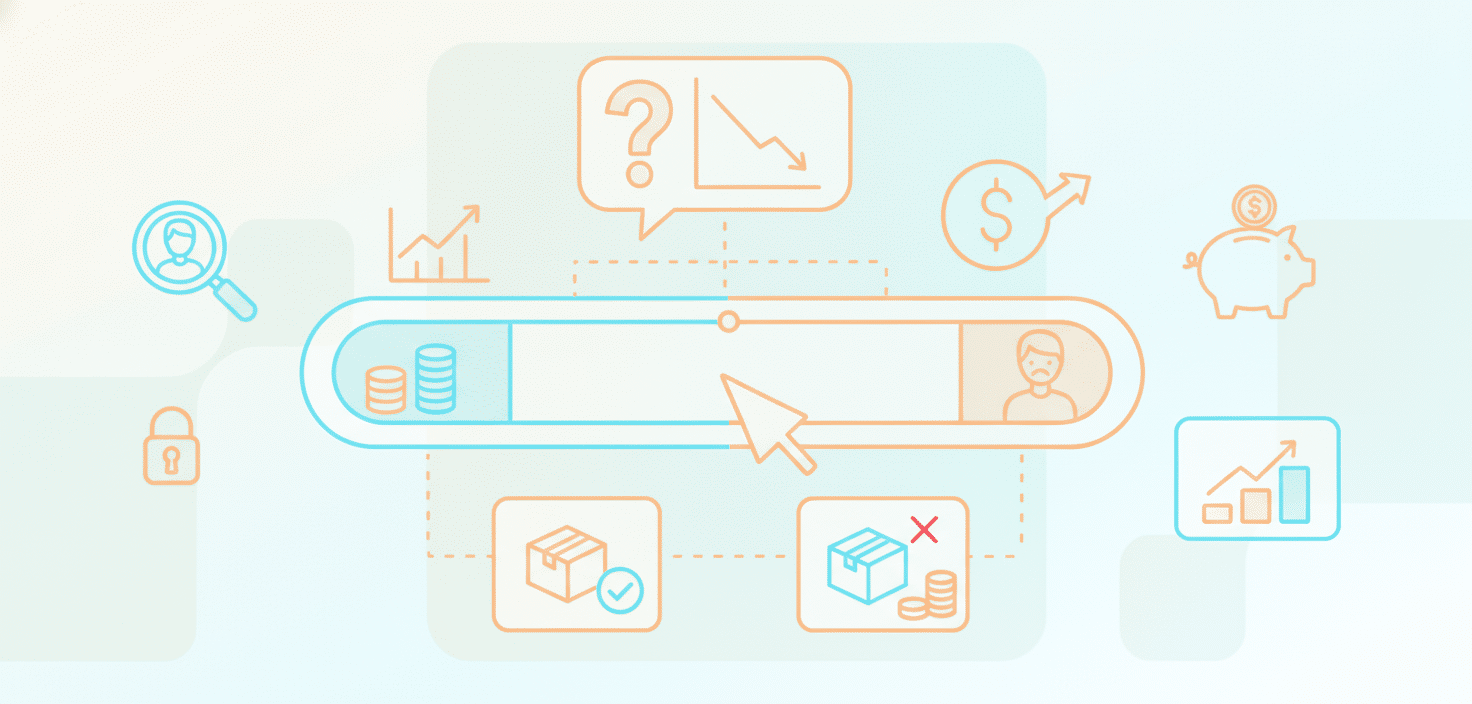시장 분석의 견고성을 더합니다.
SaaS 가격 탄력성이란 무엇인가요?

SaaS 가격 탄력성이란 무엇인가요?
SaaS 가격 탄력성은 가격 변화에 따른 SaaS 제품의 인기도를 측정합니다. 이는 가격 변동이 구매 경험에 미치는 영향을 더 자세히 이해할 수 있게 해주는 SaaS 가격 전략의 필수적인 부분입니다.
수식:
탄력성 (E) = (수요량 변화율) / (가격 변화율)
해석:
E > 1일 경우, 수요는 탄력적입니다 (가격에 매우 민감하게 반응).
E < 1일 경우, 수요는 비탄력적입니다 (가격에 덜 민감하게 반응).
SaaS 비즈니스에 가격 탄력성이 왜 중요한가요?
SaaS 기업은 회사의 가격 책정 전략과 관련된 의사 결정 과정에서 가격 탄력성을 고려할 수 있습니다.
이를 통해 가격 변화가 다음과 같은 측면에 미치는 영향을 분석하고 예측할 수 있습니다.
- 고객 확보 및 유지
- 전환율
- 고객 생애 가치 (LTV)
SaaS 가격 탄력성 데이터를 활용하는 기업은 최대 18%의 차이를 순달러 유지율에서 관찰할 수 있습니다.
SaaS 기업은 가격 탄력성을 고려해야 합니다. 그 이유는 다음과 같습니다.
- SaaS 기업이 경쟁력 있는 추론을 수행하도록 지원합니다.
- 필요하다고 판단되는 기능이나 제품을 개발합니다.
- 제공되는 가치에 따라 상품을 차별화합니다.
- 적절한 제품 구성과 판매량을 위해 번들을 세밀하게 조정합니다.
가격 탄력성이 SaaS 가격 책정에 어떻게 영향을 미치나요?
가격 탄력성은 가격 변동이 수요에 미치는 영향을 더 잘 파악할 수 있게 해주므로, 기업의 가격 전략 개발의 일부입니다.
SaaS에서 이는 고객 확보, 유지, 평생 가치에 영향을 미치며, 이 모두는 반복 매출의 핵심 요소입니다.
10% 가격 인상과 20% 판매량 감소 간의 관찰된 상관관계는 가격 탄력성을 나타낼 수 있으며, 이는 고객 행동이 가격에 의해 영향을 받는다는 것을 시사합니다.
가격 탄력성 정보를 활용한 가격 최적화는 다음으로 이어질 수 있습니다:
- 계층형 가격 책정 모델 구현
- 가치 기반 가격 책정 기법 활용
- 데이터 중심의 동적 가격 책정 모델 적용
- ML 및 AI 도구를 사용하여 사용자 그룹을 분석
SaaS 가격 탄력성을 어떻게 측정하나요?
가격 탄력성을 측정하려면:
- 가격 조정 후 구독의 백분율 변화를 계산합니다.
- 구독 가격의 백분율 변화를 계산합니다.
다음 공식을 사용하십시오:
탄력성 = (구독 변화율 (%)) / (구독 가격 변화율 (%))
예:
10% 가격 인상이 5% 구독 감소로 이어질 경우 → 탄력성 = -0.5 (비탄력적).
전문가 팁:
- 다음을 통해 측정 정확도를 향상시키십시오:
- 시장 조사
- 경제 지표
- 세그먼트 테스트
- 머신러닝 기술
내 SaaS 제품의 고객 가격 민감도를 어떻게 테스트할 수 있나요?
- 귀사의 SaaS 제품에 대한 가격 책정을 테스트할 때 따라야 할 단계는 다음과 같습니다:
- 구매자가 가치를 인식하는 방식에 초점을 맞춰 구매자 페르소나를 만드세요
- 다양한 가격을 평가하기 위해 Van Westendorp 가격 민감도 측정(PSM) 방법을 활용하세요
고객이 가격에 얼마나 민감한지 테스트하려면:
다음을 실행하세요:
- A/B 테스트
- 민감도 분석
- 시나리오 분석
다음을 다양하게 테스트하세요:
- 가격대
- 패키지 옵션
- 가치 지표
예:
Front는 가정 검증 및 가격 책정 오류 감소를 위해 3주마다 가격 책정을 테스트합니다.
가격 책정 및 수익 개선을 위해서는 지속적인 모니터링과 실험이 필요합니다.
가격 탄력성을 고려할 때, SaaS 가격 책정에 어떤 요소들이 영향을 미치나요?
SaaS에 대한 고객의 지불 의사를 어떻게 결정할 수 있나요?
소비자가 기꺼이 지불할 가격을 확인하기 위해:
- 제품의 인지된 가치를 조사하고 이해하십시오.
- 고객이 지불할 의향이 있는지 알아보기 위해 설문조사 및 인터뷰를 실시하십시오.
- 기준점을 설정하기 위해 경쟁사의 가격을 검토하십시오.
- 제품 비용을 구매자가 얻는 가치와 연결하는 가치 기반 가격 책정을 활용하십시오.
예:
귀사의 SaaS가 고객의 시간을 주당 10시간 절약해준다면, 절약된 시간을 금전적 가치로 환산하여 고객이 얼마를 지불할 의향이 있는지 파악하십시오.
가격을 수용할 수 있도록 범위로 제시해야 합니다. 고객 세분화 및 협상.
SaaS 가격은 언제 비탄력적이라고 간주되나요?
가격 변화가 수요에 거의 또는 전혀 영향을 미치지 않을 때, SaaS 가격은 비탄력적이라고 합니다. 이는 사용자가 가격에 크게 민감하지 않다는 것을 보여줍니다.
이는 SaaS 제품이 운영상 필수적이라고 여겨질 때 발생합니다.
비탄력성을 확보하려면, SaaS를 사치품이 아닌 필수적이고 미션 크리티컬한 도구로 제시해야 합니다.
결론
SaaS 가격 탄력성은 제품의 수요가 가격 변화에 얼마나 민감한지를 측정하는 핵심적인 지표이며, 가격 전략에 직접적인 영향을 미칩니다. 탄력성을 계산하고 해석하는 방법을 이해하고, 고객 가격 민감도를 테스트하며, 영향 요인을 고려함으로써 SaaS 기업은 더 나은 고객 확보, 유지, 그리고 전반적인 수익을 위해 가격 모델을 최적화할 수 있습니다.